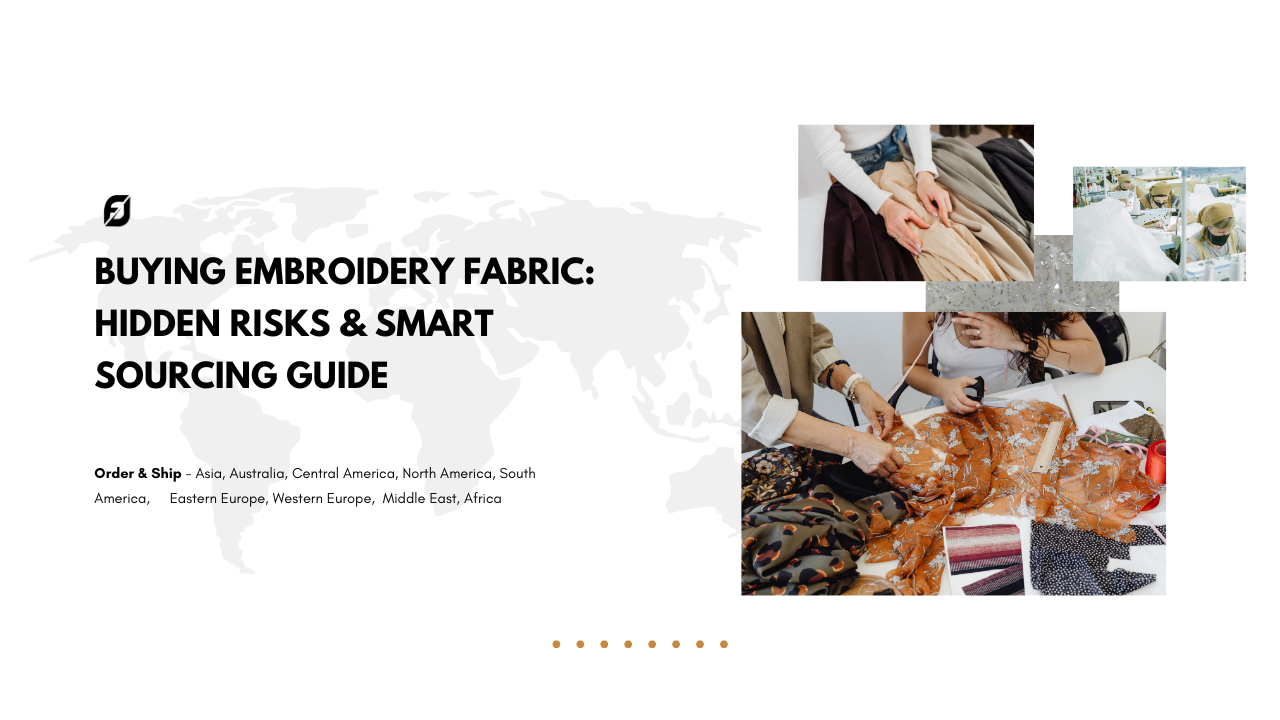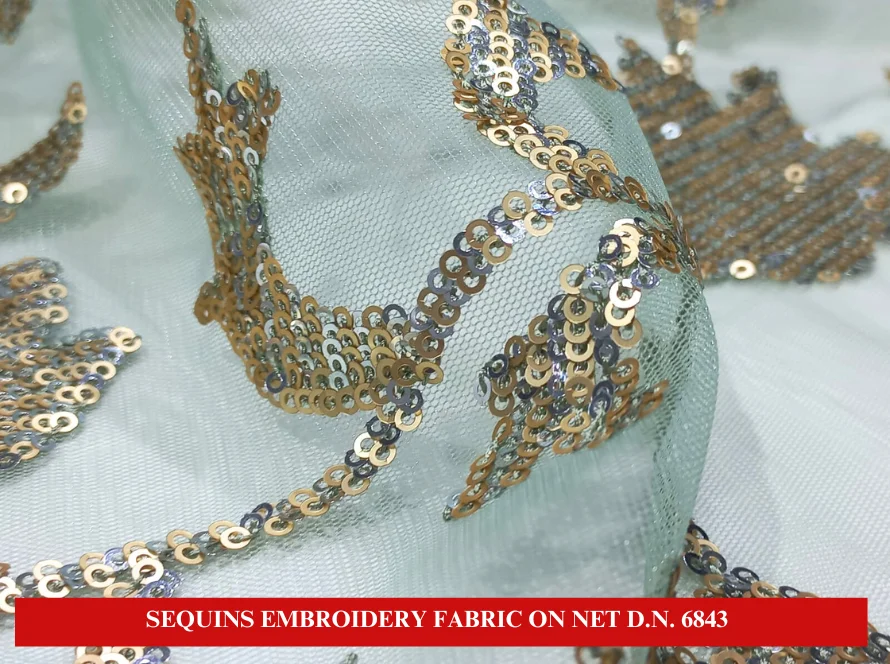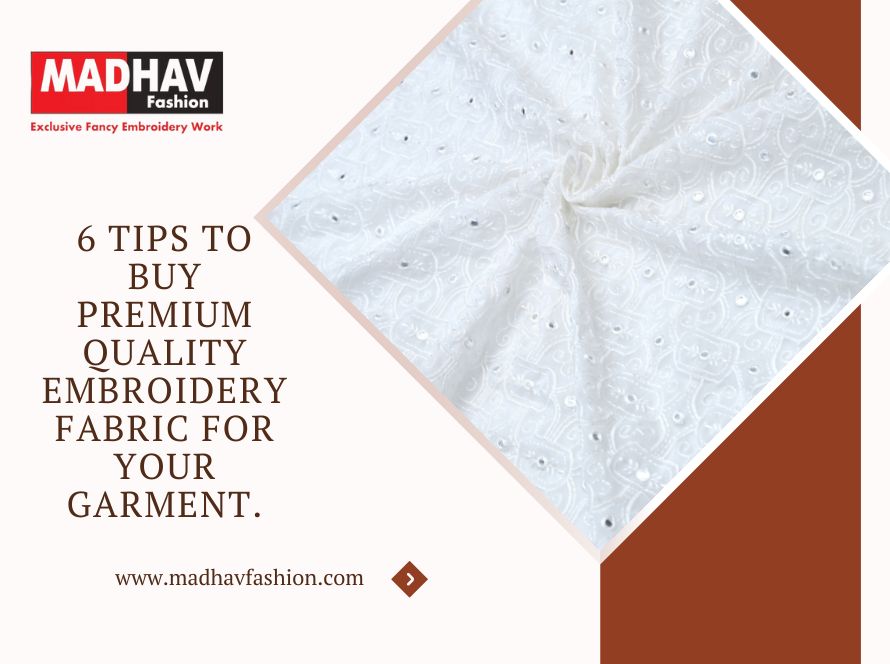When working with dyeable beads with sequins embroidery fabric, one of the most common questions from buyers, especially those purchasing from Madhav Fashion, is whether the beads and sequins will absorb color during the dyeing process.
The answer varies depending on the type of beads, sequins, and threads used in the fabric.
Understanding Dyeing of Beads with Sequins Embroidery Fabric: Key Considerations
The Dyeing Process and Its Effects
- Beads:
- Absorbent Beads: Some beads are made from materials that readily absorb dye, leading to a change in color during the dyeing process. These beads are often matte or slightly porous, and their color can deepen or alter significantly when exposed to dye.
- Non-Absorbent Beads: On the other hand, beads with a glossy or polished finish often resist dyeing. These beads typically maintain their original color, regardless of the dye used on the fabric.
- Sequins:
- Standard Sequins: Sequins are usually made from plastic or PVC materials, which are less likely to absorb dye. However, under certain conditions, like high-temperature dyeing, some sequins might slightly change color, but this is not common.
- Metallic Sequins: Sequins with a metallic finish are particularly resistant to dye. They retain their shine and original color even after the fabric has been dyed.
- Threads:
- Cotton and Silk Threads: These natural fibers tend to absorb dye well, resulting in a uniform color across the fabric, including the embroidered areas.
- Synthetic Threads: Threads made from polyester or nylon may or may not absorb dye, depending on the dyeing method. In some cases, these threads may resist dye, leaving them in their original color, which can create a unique contrast effect in the embroidery.

Key Considerations for Dyeing
When planning to dye beads with sequins embroidery fabric, it’s important to consider the type of beads, sequins, and threads used. Here are some tips to ensure the best results:
- Test Before Full Dyeing: Always conduct a small patch test to see how the beads, sequins, and threads react to the dye.
- Consult with Experts: If you’re unsure, consult with fabric dyeing experts or the manufacturer, like Madhav Fashion, who can provide guidance based on the specific materials used in the fabric.
- Choose the Right Dye: Select dyes that are compatible with the fabric and embellishments to achieve the desired color outcome.
By understanding these factors, you can make informed decisions when dyeing beads with sequins embroidery fabric, ensuring that the final product meets your expectations in terms of color and quality.
__________________________________________
What happens to beads when dyeing beads with sequins embroidery fabric?
Beads used in sequins embroidery fabric can react differently to dye, depending on their material. Beads made from absorbent materials, such as certain types of glass or matte-finish beads, may change color during the dyeing process. These beads are porous and can absorb dye, resulting in a darker or altered hue. On the other hand, non-absorbent beads, like those with a glossy or polished finish, typically resist dyeing. These beads are often made from materials like plastic or metal, which do not allow the dye to penetrate.

Therefore, they retain their original color even after the fabric is dyed. It’s crucial to understand the type of beads used in the fabric before dyeing, as this will determine the final appearance of the embroidery. Conducting a patch test or consulting with the manufacturer, such as Madhav Fashion, can help you predict the outcome and ensure that the beads complement the fabric’s new color. This knowledge is essential to achieving the desired look and maintaining the quality of the embroidered fabric.
Will sequins change color when dyeing fabric?
Sequins are generally made from plastic or PVC materials that are less likely to absorb dye. As a result, they often retain their original color, even after the fabric is dyed. However, there are some exceptions. Under high-temperature dyeing conditions, certain types of sequins might slightly change color, although this is uncommon. Metallic sequins, in particular, are known for their resistance to dyeing. These sequins are coated with a metallic finish that does not absorb dye, ensuring that they maintain their shine and color regardless of the dye used.

This characteristic can create a beautiful contrast between the dyed fabric and the sequins, enhancing the overall design. If you’re dyeing fabric with sequins, it’s important to consider how the sequins will interact with the dye. For those looking to achieve a specific effect, testing the fabric before full-scale dyeing or consulting with experts can provide valuable insights. Understanding the behavior of sequins during dyeing helps in achieving the desired aesthetic without compromising the quality of the embellishments.
How do threads used in sequins embroidery fabric react to dye?
Threads in sequins embroidery fabric can be made from various materials, and their reaction to dye depends on their composition. Natural fibers like cotton and silk absorb dye well, resulting in a uniform color that matches the rest of the fabric. These threads are ideal for achieving a cohesive look in the dyed fabric, as they take on the color evenly. Synthetic threads, such as polyester or nylon, may behave differently. Some synthetic threads are designed to resist dye, meaning they may retain their original color after the fabric is dyed.
This can create an interesting contrast effect in the embroidery, where the threads stand out against the dyed background. It’s important to identify the type of thread used in your fabric before dyeing. If a uniform color is desired, choosing natural fiber threads or using dyes specifically designed for synthetic fibers can help achieve that look. Testing a small section of the fabric before full dyeing is recommended to ensure the threads react as expected, preserving the quality and design of the embroidery.
How can I ensure a uniform dyeing result for beads, sequins, and threads?
Achieving a uniform dyeing result for beads, sequins, and threads requires careful consideration of the materials used in the fabric. First, identify the types of beads, sequins, and threads in your fabric. Beads made from absorbent materials like certain glass types may change color, while non-absorbent beads, such as plastic or metal, typically resist dye. Sequins, especially those with a metallic finish, are usually resistant to dye and maintain their original color.
Threads can vary; natural fibers like cotton and silk will absorb dye uniformly, while synthetic fibers may resist dyeing, creating contrast. To ensure a uniform result, conduct a patch test on a small section of the fabric before proceeding with full-scale dyeing. This will help you see how each element reacts to the dye. If inconsistencies arise, you may need to adjust the dyeing process, such as using a different dye type or method. Consulting with experts or the fabric manufacturer, like Madhav Fashion, can also provide valuable guidance on achieving the desired uniformity in your dyed fabric.
What precautions should I take when dyeing beads with sequins embroidery fabric?
When dyeing beads with sequins embroidery fabric, it’s essential to take several precautions to ensure the best results. First, identify the materials of the beads, sequins, and threads in your fabric. Beads made from absorbent materials may change color, while non-absorbent beads and metallic sequins typically resist dye. Conduct a patch test to see how these elements react to the dye. Choose a dye that is compatible with the fabric and its embellishments.
For instance, use dyes designed for synthetic fibers if the threads are polyester or nylon. If you aim for a uniform color, consider the possibility of some beads or sequins resisting dye. In such cases, using a dye that works well with both the fabric and its embellishments is crucial. Additionally, consider the dyeing temperature, as high heat can affect the outcome. Sequins, in particular, may change color if exposed to excessive heat. Lastly, consult with experts or the manufacturer, like Madhav Fashion, for specific guidance on dyeing their fabrics. These precautions will help you achieve a successful and satisfying dyeing outcome.
Can I dye beads with sequins embroidery fabric at home?
Dyeing beads with sequins embroidery fabric at home is possible, but it requires careful preparation and attention to detail. Before starting, identify the types of beads, sequins, and threads used in the fabric. Beads made from absorbent materials may change color during dyeing, while non-absorbent beads and metallic sequins typically resist dye. Understanding these characteristics is crucial to achieving the desired outcome. Begin with a small patch test to see how the fabric and its embellishments react to the dye. This will help you determine if the dye is compatible with all components.
If the test is successful, proceed with the dyeing process, following the instructions provided with the dye. Ensure you use the correct dye type for the fabric, whether it’s for natural or synthetic fibers. Maintain the recommended dyeing temperature, as high heat can affect beads and sequins. Additionally, be prepared for the possibility that not all elements will absorb the dye uniformly, which could result in a contrast effect. If you’re unsure about the process, consulting with a professional or the fabric manufacturer, like Madhav Fashion, can provide valuable guidance.
What are the challenges of dyeing beads with sequins embroidery fabric?
Dyeing beads with sequins embroidery fabric presents several challenges, primarily due to the varying materials used in the fabric. Beads, sequins, and threads can react differently to dye, making it difficult to achieve a uniform color. Beads made from absorbent materials, like certain types of glass, may change color, while non-absorbent beads, such as those made from plastic or metal, often resist dyeing and retain their original color. Sequins, particularly metallic ones, are generally resistant to dye, which can lead to a contrasting effect if the fabric itself absorbs the dye.
Threads used in the embroidery can also pose a challenge. Natural fibers like cotton or silk absorb dye well, but synthetic threads may not, resulting in an uneven color distribution. The dyeing temperature can also affect the outcome, as high heat might alter the color of certain beads or sequins. To overcome these challenges, it’s essential to conduct a patch test before dyeing the entire fabric. Consulting with experts or the manufacturer, such as Madhav Fashion, can also help you navigate these challenges and achieve the desired results.
How can I prevent beads from changing color during dyeing?
Preventing beads from changing color during dyeing involves selecting the right type of beads and controlling the dyeing process. Beads made from non-absorbent materials, such as plastic or metal with a glossy or polished finish, are less likely to absorb dye and change color. Before dyeing, it’s crucial to identify the type of beads used in your fabric. If you’re unsure, consult with the fabric manufacturer, like Madhav Fashion, to get detailed information about the beads. To further prevent color change, conduct a patch test on a small section of the fabric to see how the beads react to the dye. Use a dye that is specifically designed to work with the fabric type without affecting the beads. Additionally, control the dyeing temperature, as excessive heat can sometimes cause unexpected changes in the beads’ color. If the beads still change color despite these precautions, consider using a protective coating on the beads before dyeing, which can act as a barrier and prevent dye absorption. Following these steps can help you maintain the original appearance of the beads during the dyeing process.
Why do some beads change color while others don’t during dyeing?
The color change in beads during dyeing depends on the materials and finishes used in their manufacturing. Beads made from absorbent materials, such as certain types of glass or matte-finish beads, have a porous structure that allows them to absorb dye, resulting in a color change.
These beads are more likely to alter their appearance during the dyeing process. Conversely, beads made from non-absorbent materials, like plastic or metal with a glossy or polished finish, resist dye absorption. These beads are coated or treated in a way that prevents dye from penetrating their surface, allowing them to maintain their original color. The finish of the beads also plays a significant role. Beads with a matte or rough finish are more prone to absorbing dye, while those with a smooth, shiny, or polished finish are less likely to
do so. Understanding the material and finish of the beads used in your fabric is essential for predicting how they will react to dyeing. Conducting a patch test before full-scale dyeing can help identify which beads will change color and which will not, allowing you to achieve the desired effect.
How does the dyeing temperature affect beads and sequins in embroidery fabric?
The dyeing temperature plays a crucial role in determining how beads and sequins in embroidery fabric will react. High dyeing temperatures can cause certain beads, especially those made from glass or natural materials, to change color as they absorb the dye more readily. These beads may also expand or contract slightly, affecting their appearance and how they sit on the fabric. Sequins, particularly those made from plastic or PVC, are generally resistant to dye. However, excessive heat can cause some sequins to warp or lose their shine, altering the overall look of the fabric.
Metallic sequins are less affected by temperature changes but still require careful handling to avoid any potential damage. To prevent unwanted effects, it’s important to control the dyeing temperature based on the materials used in your fabric. Conducting a patch test at the desired temperature will help you gauge how the beads and sequins will respond. If the results are not satisfactory, adjusting the temperature or using a different dyeing method may be necessary. Consulting with the fabric manufacturer, like Madhav Fashion, can also provide guidance on the optimal dyeing conditions for your specific fabric.






